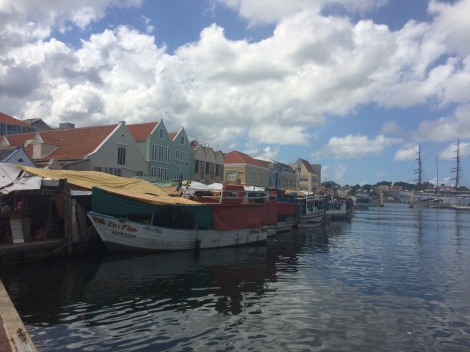
Willemstad (Punda), Curacao
Even today, the signs are all still there. The Maduro and Curiel’s bank, the Senior Curacao Blue liquor, the Gomez store, the Penha building, and the Jewish year 5466 written above a shop. While today there are just a few hundred Jews living on this island of one hundred and fifty thousand people, in the eighteenth century more than a third (1500 persons) of the island’s European population was Jewish. And, of course, by Jewish I mean Portuguese Jewish. At that time Curacao was home to the largest Jewish community in the Americas (click here to learn about the island’s historic Jewish cemeteries). Some even suggest that the local composite language Papiamento was in part influenced by all of these Jewish Portuguese speakers. Dutch Protestants controlled local government and most agriculture, but trade was primarily in the hands of the island’s Jewish population.

Curacao Topography
This Jewish concentration in commercial activity was exactly what Curacao’s then former governor Peter Stuyvesant counseled against in 1651 (he was there in the 1640s). That year, a small group of Jews was permitted to settle on the Dutch controlled island on the condition that they focused their efforts on cultivating the land. The Dutch wanted a sugar island, and Portuguese Jews, from their time in Portugal and Brazil, had the knowhow for how to do that. However, Curacao is too arid for sugar cane cultivation, a fact that seems all too clear from the all of the cacti growing across the island! Portuguese Jews, the merchant class of Portugal, soon refocused their efforts towards what they knew best, international trade.

Small Shipping Boats – Portuguese Jews Used Schooners
Portuguese Jews were further drawn to Curacao following the collapse of Dutch Brazil in 1654. Recife, Brazil had been home to a large Dutch Portuguese Jewish community. Thankfully, Dutch authorities agreed to peacefully surrender the territory to the Portuguese fleet only under certain conditions. One of which was a three month window during which all of the colony’s Jews could safely depart without any Inquisitorial activity directed against them. Many of these professing Jews were technically baptised Catholics from their former converso days in Portugal. Brazilian Portuguese Jews scattered. Many went back to Holland, some relocated to various Caribbean islands (like Barbados and Jamaica), and one group even went to the island of New Amsterdam, where they were unwelcome by its new governor, Peter Stuyvesant!

Venezuelan Fruits Sold in Curacao
Curacao’s close proximity to Spanish Venezuela afforded Portuguese Jews the opportunity to carry on their important trade connections with the Iberian peninsula and its New World markets. Curacao’s Jews played a vital role in connecting Protestant Netherlands to important New World products such as cocoa, wood, sugar, and indigo. As a result many Curacao Jews became fabulously wealthy. One area of trade, however, that was denied to these Dutch Jews was the slave trade, as the Dutch West India company considered it too lucrative to share with them.

Curacao’s New Maritime Economy – Cruise Ships
Curacao’s economic position declined in the 19th century, and its Jewish population numbers followed in kind. Many Curacao Jews moved to other places in the Caribbean, as well as to neighbouring areas in Central and South America. Often, they established the first Jewish communities in those locations. Still, a Portuguese (Reconstructionist) Jewish community persists in Curacao today (as well as an Ashkenazi Orthodox one), but more on that in an upcoming post!

Willemstad (Punda), Curacao
Wish List
The most important work on this subject is now out of print and is very expensive. If someone would like to buy me a gift, here is the link :).
Very interesting. Thanks.
On 16 February 2017 at 23:50, Shalom Says Hello wrote:
> shalommorris posted: ” Even today, the signs are all still there. The > Maduro and Curiel’s bank, the Senior Curacao Blue liquor, the Gomez store, > the Penha building, and the Jewish year 5466 written above a shop. While > today there are just a few hundred Jews living on this isla” >
Pingback: Mikve Israel-Emanuel – Curacao | Shalom Says Hello·
Pingback: Curacao’s Jewish Archives and Cemeteries | Shalom Says Hello·
Pingback: Post #100 – Bevis Marks, World’s Longest Running Synagogue | Shalom Says Hello·
Pingback: Eating Black-Eyed Peas in the Caribbean’s Lost Jewish Colony | Poppy and Prune·